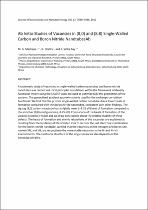 ResearchSpace
ResearchSpace
Ab initio studies of vacancies in (8,0) and (8,8) single-walled carbon and boron nitride nanotubes
JavaScript is disabled for your browser. Some features of this site may not work without it.
- ResearchSpace
- →
- Research Publications/Outputs
- →
- Journal Articles
- →
- View Item
| dc.contributor.author |
Mashapa, MG

|
|
| dc.contributor.author |
Chetty, N

|
|
| dc.contributor.author |
Ray, Suprakas S

|
|
| dc.date.accessioned | 2012-09-03T09:44:19Z | |
| dc.date.available | 2012-09-03T09:44:19Z | |
| dc.date.issued | 2012-09 | |
| dc.identifier.citation | Mashapa, MG, Chetty, N and Ray, S.S. 2012. Ab initio studies of vacancies in (8,0) and (8,8) single-walled carbon and boron nitride nanotubes. Journal of Nanoscience and Nanotechnology, vol. 12(9), pp 7030-7036 | en_US |
| dc.identifier.issn | 1533-4880 | |
| dc.identifier.uri | http://www.ingentaconnect.com/content/asp/jnn/2012/00000012/00000009/art00022?token=00411429fc7b437a63736a6f3b47655d7a763f5f6a2a566f642f4642ac9a7f981 | |
| dc.identifier.uri | http://www.aspbs.com/jnn/ | |
| dc.identifier.uri | http://hdl.handle.net/10204/6076 | |
| dc.description | Copyright: 2012 American Scientific Publishers. This is an ABSTRACT ONLY. | en_US |
| dc.description.abstract | A systematic study of vacancies in single-walled carbon nanotubes and boron nitride nanotubes was carried out. First principles calculations within the framework of density functional theory using the CASTEP code are used to optimize fully the geometries of the systems. The generalized gradient approximation is used for the exchange-correlation functional. We find that the pristine single-walled carbon nanotubes have lower heats of formation compared with the boron nitride nanotubes, consistent with other findings. The zig-zag (8,0) carbon nnaotube has a slightly lower (-3.32 eV) heat of formation compared to the armchair (8,8) configuration (-3.25 eV). Comparison of the heats of formation of the vacancy systems is made and we draw conclusions about the relative stability of these defects. The heats of formation and atomic relaxations of the vacancies are explained as resulting from the tendency of the affected ions to recover the lost electronic coordination. For the boron nitride nanotube, we find that the vacancies on the nitrogen and boron site, namely VN, and VB, are respectively the more stable vacancies in the B- and N-rich environments. The electronic structure of the single vacancies also depends on the nanotube chirality. | en_US |
| dc.language.iso | en | en_US |
| dc.publisher | American Scientific Publishers | en_US |
| dc.relation.ispartofseries | Workflow;9486 | |
| dc.subject | Ab Initio | en_US |
| dc.subject | Single-Walled carbon nanotubes | en_US |
| dc.subject | Boron nitride nanotubes | en_US |
| dc.subject | Vacancy defects | en_US |
| dc.subject | Electronic properties | en_US |
| dc.subject | Heats of formations | en_US |
| dc.title | Ab initio studies of vacancies in (8,0) and (8,8) single-walled carbon and boron nitride nanotubes | en_US |
| dc.type | Article | en_US |
| dc.identifier.apacitation | Mashapa, M., Chetty, N., & Ray, S. S. (2012). Ab initio studies of vacancies in (8,0) and (8,8) single-walled carbon and boron nitride nanotubes. http://hdl.handle.net/10204/6076 | en_ZA |
| dc.identifier.chicagocitation | Mashapa, MG, N Chetty, and Suprakas S Ray "Ab initio studies of vacancies in (8,0) and (8,8) single-walled carbon and boron nitride nanotubes." (2012) http://hdl.handle.net/10204/6076 | en_ZA |
| dc.identifier.vancouvercitation | Mashapa M, Chetty N, Ray SS. Ab initio studies of vacancies in (8,0) and (8,8) single-walled carbon and boron nitride nanotubes. 2012; http://hdl.handle.net/10204/6076. | en_ZA |
| dc.identifier.ris | TY - Article AU - Mashapa, MG AU - Chetty, N AU - Ray, Suprakas S AB - A systematic study of vacancies in single-walled carbon nanotubes and boron nitride nanotubes was carried out. First principles calculations within the framework of density functional theory using the CASTEP code are used to optimize fully the geometries of the systems. The generalized gradient approximation is used for the exchange-correlation functional. We find that the pristine single-walled carbon nanotubes have lower heats of formation compared with the boron nitride nanotubes, consistent with other findings. The zig-zag (8,0) carbon nnaotube has a slightly lower (-3.32 eV) heat of formation compared to the armchair (8,8) configuration (-3.25 eV). Comparison of the heats of formation of the vacancy systems is made and we draw conclusions about the relative stability of these defects. The heats of formation and atomic relaxations of the vacancies are explained as resulting from the tendency of the affected ions to recover the lost electronic coordination. For the boron nitride nanotube, we find that the vacancies on the nitrogen and boron site, namely VN, and VB, are respectively the more stable vacancies in the B- and N-rich environments. The electronic structure of the single vacancies also depends on the nanotube chirality. DA - 2012-09 DB - ResearchSpace DP - CSIR KW - Ab Initio KW - Single-Walled carbon nanotubes KW - Boron nitride nanotubes KW - Vacancy defects KW - Electronic properties KW - Heats of formations LK - https://researchspace.csir.co.za PY - 2012 SM - 1533-4880 T1 - Ab initio studies of vacancies in (8,0) and (8,8) single-walled carbon and boron nitride nanotubes TI - Ab initio studies of vacancies in (8,0) and (8,8) single-walled carbon and boron nitride nanotubes UR - http://hdl.handle.net/10204/6076 ER - | en_ZA |





